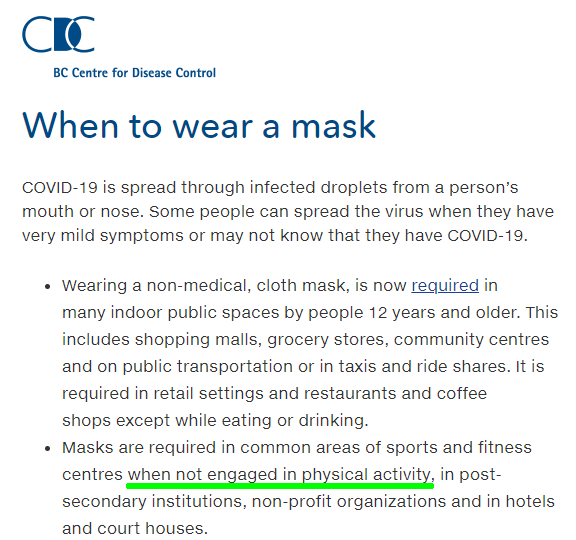Don’t wear a mask while exercising, says WHO – World Health Organization
The World Health Organization says it can be harmful to wear a mask during your quarantine run or cycle ride.
Wearing face masks outdoors and in crowded indoor areas is recommended by public health officials to curb the spread of the novel coronavirus. However, the important preventive measure during exercise is to maintain physical distance of at least one meter from others.
“People should NOT wear masks when exercising as masks may reduce the ability to breathe comfortably,” says the WHO in its series of coronavirus mythbusters.
Exercise, particularly running or jogging, increases the heart and breathing rate, and a mask can prevent sufficient oxygen from getting to any person’s lungs. The lungs then work harder to get oxygen, which can cause lightheadedness and dizziness.

Source: WHO.int – https://www.who.int/emergencies/diseases/novel-coronavirus-2019/advice-for-public/myth-busters#exercising
BC Health Also says NOT TO WEAR A MASK WHLE WORKING OUT.
“Masks are required in common areas of sports and fitness centres when not engaged in physical activity.” BCCDC

In early May there were reports of a jogger in Wuhan who ended up in a hospital after he went for a run wearing a mask. One of the man’s lungs had collapsed and he needed surgery for it.
The hospital that treated him later advised against wearing masks while exercising vigorously.
There is also a possibility that excessive sweating can make the mask become wet more quickly which can lead to the growth of microorganisms, according to the WHO.
For this reason, some experts advise people to wear certain types of masks during exercise.
Avoid paper, surgical masks during exercise, says exercise professor Dr Christa Janse van Rensburg at the University of Pretoria, reported The New York Times.
“They rapidly become wet when we breathe into them and lose their ability to block outgoing germs. Cotton cloth masks likewise dampen easily. Cloth masks made from breathable, synthetic materials should lessen moisture buildup.”
The exercise scientist says people should choose models that “have two layers of fabric or less,” to prevent overheating.
Formal studies have not been conducted on exercise and face masks.
However, the US Centres for Disease Control and Prevention say: “If people engaged in high intensity activities are unable to wear a cloth face covering, consider conducting the activity in a location with greater ventilation and air exchange (for instance, outdoors versus indoors) and where it is possible to maintain physical distance from others.”
Walking is not considered a high intensity exercise.
Source: WHO.int
Source: BCCDC
Source: Healthsite





Recent Comments